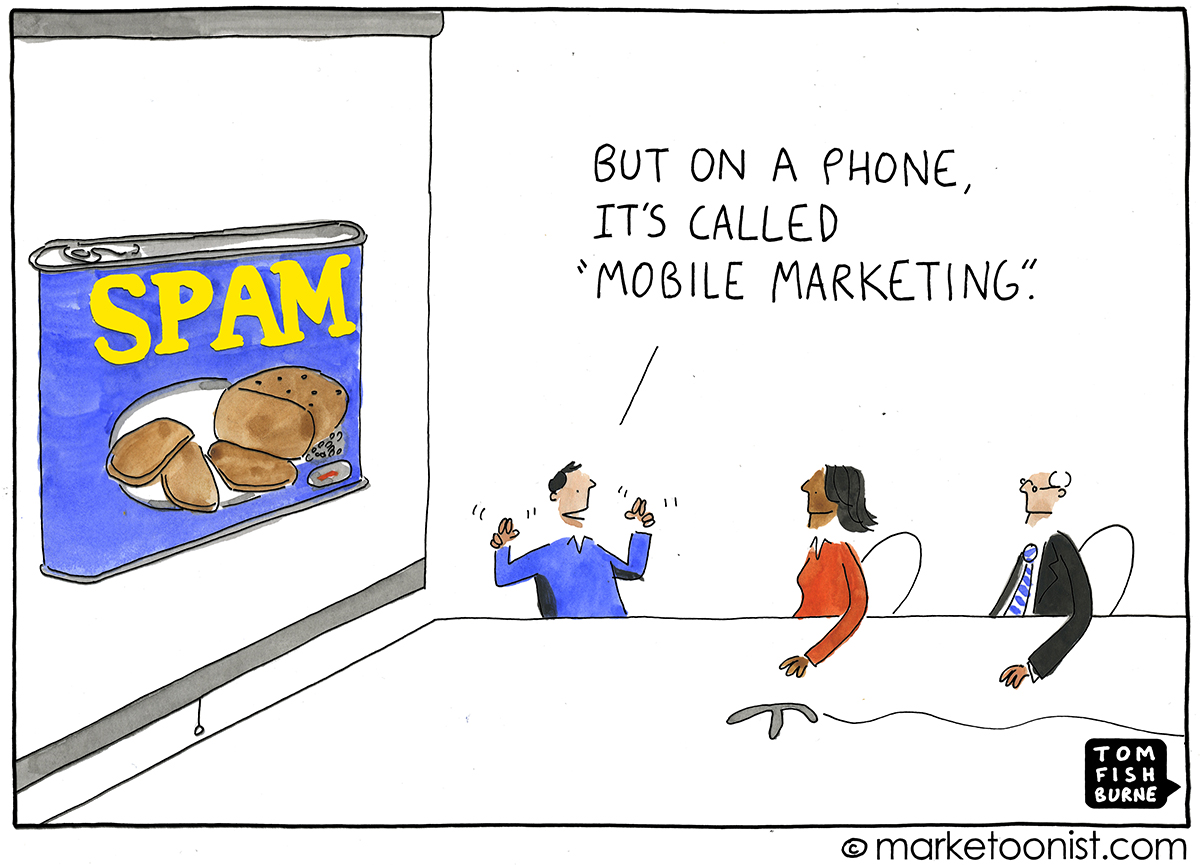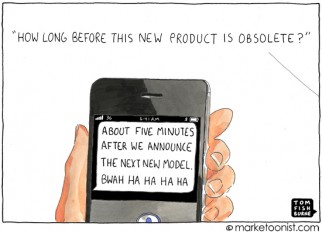Mobile is the next frontier for marketing. Not all mobile marketing is spam, of course, but many current campaigns feature exactly that — unwanted, unsolicited SMS text messages.
The potential of mobile marketing is far more powerful — location-specific, time-based, highly personalized messaging. It has the potential to offer real utility to consumers. But the current state seems more geared to interrupt than create value.
Spam is far broader than it’s legal distinction. Just because marketers can doesn’t mean they should. As marketers think about reaching consumers through their mobile devices, they should pay attention to this perspective from Seth Godin:
“Spam is unanticipated, impersonal, irrelevant junk I don’t want to get. Not only that, it costs them less to send it than it takes me to figure out what it is and deal with it. That doesn’t scale. In fact, it destroys the medium … Maybe I’m getting cranky, but the relentless march of marketers into our lives is really getting to me.
In case you missed the first part of our show, the future of marketing is based on permission. It’s based on sending messages to people who want to get them, who choose to get them, who would miss you if you didn’t send them.It’s not easy and it’s not cheap to earn permission, but so what? This is my attention, not yours, and if you want to use it for a while, please earn the privilege.”
A brand that has earned that privilege in another medium is Betabrand. Betabrand sends out a weekly email. Most corporate email newsletters are considered spam, with open rates averaging in the low single digits. At a panel a couple weeks ago, I heard founder Chris Lindland share that his email open rates averaged at 45%. Their audience would miss the emails if they weren’t there.
As mobile marketing matures, that’s the level of permission marketing I hope that more brands follow.
(Marketoonist Monday: I’m giving away a signed print of this week’s cartoon. Just share an insightful comment to this week’s post. I’ll pick one comment by 5:00 PST on Monday. Thanks!)



Mark Bowley says
As usual, very timely and accurate Tom. I wish the permission idea would be applied to cold callers on land line phones too – how many of them realise they are spam marketing?
Kevin McFarthing says
Hi Tom – good points as always. The thing that “interruption” marketers seem to miss is they actually create a NEGATIVE impression of their brand with people they annoy. Rather than seeking the right time to engage, they seek the highest number of impressions, count the various conversion rates but completely ignore the people they’ve turned off for the foreseeable future.
There seems to be too much of a TV coverage mindset at work, where marketers seek the largest audience in the hope of converting enough people to get a good ROI. The difference is that by watching a TV program with ad breaks, consumers know they’re giving permission to the advertisers. Paying to watch ad-free channels enforces this belief, as consumers don’t expect ads. We want to avoid unwanted phone calls, SMS and email. We don’t give permission for that.
K Power says
I purchase mobile texting/telephone service for MY convenience, and for the convenience of those select individuals to whom I choose to give the number.
Reaction to receiving spam messages, voice or text, on my mobile ranges from making me irritated to irrate. The only thing these messages guarantee is that I will Never purchase the product or use the service.
This is an invasion of personal privacy and ads or invasions of any type are unwelcome.
If a particular product or brand holds enough interest for me to follow it, keep it simple to sign up for those updates and I will choose the venue. The incursions are then welcome.
DSprogis says
While Godin has done a reasonable job capturing the essence of “spam” I think he too quickly narrows it with “costs them less to send it than it takes me to figure out what it is and deal with it”. The marketing cost is interesting to consider but I have had plenty of unwanted phone calls that had a high labor cost and just the other day I received a catalog from Restoration Hardware that must have cost a fortune to print and ship. This catalog tortured the environmentalist in me – I hated tossing it in the recycle bin without ever cracking it open.
Mobile advertising, however, seems to be the worst because it intrudes on me financially as well as consuming my time and attention. I don’t want to pay for TXTs or minutes for unwanted messages or solicitations.
I feel public signage is abused with advertising too. Fastlane in Massachusetts is a great example. When I am approaching a toll both and choosing a lane, the fact that Citizen’s Bank is connected to the Fastlane transactions does not help me pick the correct lane. A better use of the visual real estate would be to mention that it accepts EasyPass (NY) and other states’ programs. I have a similar reaction to Adopt-a-highway, Adopt-a-park and other signage that trades advertising for maintenance costs. We have way too much coming at us and there is a need to cut it back.
I contemplate the need for a legislated “social contract” – like a Bill of Rights – that protects us with an opt-in for all messaging and communication.
Karl Sakas says
When it comes to opt-in, it seems wireless providers aren’t making it any easier — the New York Times recently shared how companies like Verizon Wireless and AT&T don’t do a great job policing companies that inappropriately add $9/month charges to customers’ bills. http://www.nytimes.com/2012/04/08/your-money/cellphone-cramming-gets-a-second-look.html
The cell phone providers will cancel the service and often refund the charges, but that doesn’t solve the problem in the first place — and it puts the onus on consumers to defend themselves.
Rebecca McCormick says
SMS gives a campaign the added power to communicate with your target customer and build on the relationship you have with them based on permission and trust. Adding SMS to a campaign allows consumers to text for more information so the follow-up is able to become more targeted.We are also seeing the rise of smartphone technology. No longer are you limited to 160 characters of text – the use of Smartphone technology and the public acceptance of tiny URLs on social media platforms, means that SMS can be used as tool to link to a bigger picture. SMS can now be used as the ‘hook’ needed to direct the reader to where they need to be online. Links to apps, videos and web pages are easily incorporated into an SMS message.
“Any tool which allows a business owner to grow their customer data and intelligence, and then allow you to communicate targeted messages to them directly is powerful.
See http://www.textlocal.com/ for more info.
tomfishburne says
Great commentary, everyone, thanks! This week’s winner is Kevin McFarthing. I completely agree with Kevin’s point that marketers are missing the hidden cost of those negative impressions. Spam messaging may seem like a cost-efficient way to reach a huge number of impressions, and potentially generate a few leads. But the cost of those negative impressions is often overlooked.
Thanks,
-Tom